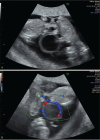Conjoined twins in a spontaneous monochorionic triplet pregnancy: A case report and literature review
- PMID: 33530268
- PMCID: PMC7850647
- DOI: 10.1097/MD.0000000000024490
Conjoined twins in a spontaneous monochorionic triplet pregnancy: A case report and literature review
Abstract
Rationale: Conjoined twins are a rare complication of monochorionic pregnancies and an extremely rare condition in spontaneous triplet pregnancies. We report a case of conjoined twins in a spontaneous monochorionic triplet pregnancy. The conjoined twins might have suffered from twin anemia-polycythemia sequence, which was reported to be extremely rare.
Patient concerns: A 26-year-old woman conceived spontaneously with an obstetric history of invasive mole 4 years ago.
Diagnoses: We initially misdiagnosed her as having monochorionic triamniotic triplets at 10 weeks of gestation. However, we confirmed conjoint twins with the monochorionic diamniotic triplet pregnancy at 12 weeks of gestation and classified them as omphalopagus.
Interventions: As the woman decided to continue the pregnancy, regular and careful antenatal care was conducted.
Outcomes: Unexpectedly, she had a stillbirth 3 weeks later and had to terminate the pregnancy at 15 weeks of gestation. After abortion, the diagnosis of omphalopagus was confirmed in the induced fetuses. Moreover, the skin colors of the conjoined twins were different: one was plethoric, and the other was pale. Additionally, the parents agreed to examine the chromosome of the fetuses, and the results were normal.
Conclusion: Dichorionic triplet and monochorionic triplet pregnancies have a poorer prognosis than trichorionic triplet pregnancies. Surgery is the main therapy for conjoined twins; however, most conjoined twins in triplet pregnancies cannot survive, including omphalopagus twins. The conjoined twins may have suffered from twin anemia-polycythemia sequence, which could probably not be diagnosed intrauterine. Transvaginal probe and 3-dimensional ultrasound may be helpful for clarifying the diagnosis in early pregnancy.
Copyright © 2021 the Author(s). Published by Wolters Kluwer Health, Inc.
Conflict of interest statement
The authors have no conflicts of interest to disclose.
Figures



Similar articles
-
Conjoined twins in dichorionic diamniotic triplet pregnancy: a report of three cases and literature review.BMC Pregnancy Childbirth. 2021 Oct 8;21(1):687. doi: 10.1186/s12884-021-04165-x. BMC Pregnancy Childbirth. 2021. PMID: 34625055 Free PMC article. Review.
-
Monochorionic triplet pregnancy complicated by conjoined twins and early twin-twin transfusion syndrome.Birth Defects Res. 2024 Feb;116(2):e2317. doi: 10.1002/bdr2.2317. Birth Defects Res. 2024. PMID: 38362599 Review.
-
Conjoined twins in a triplet pregnancy: early prenatal diagnosis with three-dimensional ultrasound and review of the literature.Ultrasound Obstet Gynecol. 2003 Aug;22(2):199-204. doi: 10.1002/uog.185. Ultrasound Obstet Gynecol. 2003. PMID: 12905520 Review.
-
Conjoined twins in a monochorionic triplet pregnancy after in vitro fertilization: a case report.Iran J Reprod Med. 2015 Nov;13(11):729-32. Iran J Reprod Med. 2015. PMID: 26730249 Free PMC article.
-
[Malformed pygopagus conjoined twins in a spontaneous triplet pregnancy].Harefuah. 2005 Aug;144(8):590-2, 596. Harefuah. 2005. PMID: 16146161 Hebrew.
Cited by
-
Conjoined twins in dichorionic diamniotic triplet pregnancy: a report of three cases and literature review.BMC Pregnancy Childbirth. 2021 Oct 8;21(1):687. doi: 10.1186/s12884-021-04165-x. BMC Pregnancy Childbirth. 2021. PMID: 34625055 Free PMC article. Review.
References
Publication types
MeSH terms
Grants and funding
LinkOut - more resources
Full Text Sources
Other Literature Sources
Research Materials

